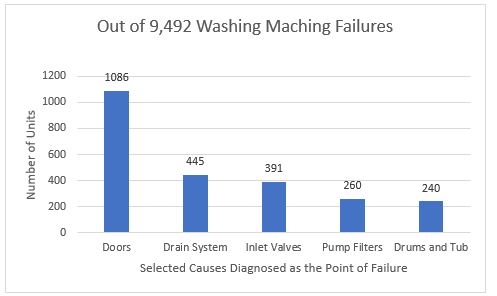The Laundry Room Is the Most Underrated Room in the House
There is not much to a washer. It brings hot and cold water in (in a controlled way) goes through many cycles to slosh the water around, drains the water, and spins to remove water from the wet clothes. And voilà! Your clothes are clean.
- Hose connections
- Hoses themselves
- Drain hose
- Washer tub
- Door seals
- Tub overflow
- Bad gaskets and clamps
Always investigating a wet floor when you find water on the floor is a key way to identify problems before they become damage.
Hose connections Must Be Checked for Leaks
The most frustrating aspect of getting a new washing machine is the water connections. Laundry rooms are not always designed for ease of access. The connections are often at an awkward angle in a cramped space. Getting the threading lined up correctly is a challenge. Once you get that set correctly, the hoses often still leak. Sometimes they spray through a bad seal and sometimes they drip slowly. A spray is quite obvious so it will be fixed right away, but if it’s a slow drip, you might not notice it at the outset. It’s a good idea, once the connections are made, to return to the connection a few hours later with a facial tissue to wipe the area down. If there is a slow drip, you should detect it easily with the absorbent tissue.
The Hoses Themselves Should Be Changed Periodically
Water hoses can be made using several different kinds of materials. The most common cause of water flooding from the washing machine is old rubber hoses.
There are a couple of popular axioms like these:
“if it ain’t broke, don’t fix it.”
– and –
“Use it up, wear it out, make it do, or do without.”
These are catchy sayings and they definitely have their place. They do NOT apply to your rubber water supply hoses. Rubber hardens as it ages and gets less and less flexible. With time, they will fail. When they burst they spray water into your laundry room and you have a mess to clean up. If nobody is home at the time that it bursts, you could be dealing with a flood that destroys flooring, drywall, and cabinetry.
Water Hammer
There is something called hydraulic transients, known by laymen as “water hammer”. This is a principle of physics that explains the banging of pipes in old houses. When you have high water pressure and you quickly turn off the water, all of the fast-flowing water in the pipe is suddenly stopped and it causes a spike in the water pressure inside the pipes.
The washing machine turns the water on and off repeatedly during the washing cycle. When you have a rubber hose supplying the water, it has to absorb this water pressure spike each time. As it ages and gets stiffer, it becomes susceptible to bursting each time you run the machine and causing flooding.
Do not use it up. Don’t wear it out. If its old (4-5 years) then it might be time to replace it.
Drain hose
The two biggest concerns you have with the drain pipe are the connections to the washer and drain, and sewer backups from the drain. Sewer backups can happen when there is a blockage somewhere in the sewer pipes from the house to the city sewer or septic system. The washing machine is not likely to cause the blockage, but it does expel water at a fast rate and if there is a blockage already, it could be the washing machine’s water that gets blocked and backed up. More about that in our section on sewer backups.
More relevant is the connection of the hose itself. While drains don’t have the stress of water pressure that water supply hoses do (because with a properly functioning sewer system there is no resistance to the flow) the water does come out of the washer with a high velocity. If the drain hose is not securely fastened to the washer or well set into the drain, that velocity can cause the hose to become detached and flood the laundry room quickly with water. Not only water, but dirty water.
The hose is usually attached to the washer with clamps and if they are not seated correctly, or if they are tugged on when installing or moving the machine, they can come loose. The hose into the drain is normally just placed there. There is often nothing securing it in place. So it can be easily displaced with moving of the machine or by curious kids.
Washer tub
Washing machine tubs are designed to hold your clothes and water while the machine works it’s cleaning magic. These metal tubs will rust over time. When a hole is rusted through, you’re going to get water leaking. There are actually two tubs, the inner one that has holes where the water is supposed to flow out, and the outer tub that should be water tight and it is that one which, if it develops a hole will start to wet your laundry room floor.

Source: https://www.sciencedirect.com/science/article/pii/S0959652619300514
Door seals
Front-loading washers need to have a good seal. If the seal is compromised you will get dirty, soapy water leaking out onto your floor. The life span of these gaskets seem to vary where they may need to be replaced after a few years, others report that they have gone a decade without replacing one. The cost of replacing gasket for your washing machine could be less than $100 for a do-it-yourselfer to the low hundreds to have a technician do it for you.
If you do have water leaking through the front door, check the seal to see if there is any obvious foreign object stuck to it, and check the latching mechanism of the door.
Tub overflow
The washing machine’s function is mechanical and fairly simple. Water fills the tub to the appropriate point, the clothes are agitated in the water, and the water is extracted by spinning the tub. The process will repeat as needed. The more complicated part is the electronic controller that determines when to fill with water, when to stop, how many times to run the agitation – and for how long, and the spin cycle. If any of the sensors go bad in that process, you could have a problem with water. Suppose the sensor that says that the tub is full fails, you could have water overflowing your tub or leaking through the door seal.
Bad gaskets and clamps
While the rubber hoses that connect to the water supply is the most common cause of laundry room flooding, there are several points inside the washer’s casing that have connectors that can fail. Different designs use different methods, but clamps can come loose, gaskets can fail and hoses inside the washer can all leak too.
If you have water underneath your washing machine, and you find that the water supply hoses and connectors are functioning properly, it’s time to get inside the casing and find where the leak is coming from. Whether you do it yourself or have a professional appliance repairman do so, you should not ignore the problem.
Conclusion
The laundry room is a wonderful feature of modern homes that is often taken for granted. When it isn’t containing the water within the washer system the way it is designed, it can cause water damage and introduce mold. Water damage can be severe and costly, and mold can also be a hazard to your health. It can be a catastrophe or subtle leak, but both can be costly and need to be fixed right away.
We don’t repair appliances. But we do address the problems that they can cause. We are here for you when if you need us to extract water from a flooded laundry room, we’ll dry the room out, and if any reconstruction is needed, we’re able to do that for you as well.
We hope you never need our services, but if the unexpected happens, Relax, and Trust Construemax.







